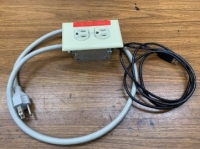Thanks for a nice, simple and cheap tip!
Q: -Are US connectors standardized when it comes to phase and neutral prongs on your plugs (and outlets)?
Over here in Europe, (and particularly here in Sweden)-
a code-abiding and pertinent safety factor would be to make a 2 pole switch,
breaking
both the neutral and phase connector,
whilst keeping the Protective Earth connected at all times.
That could easily be done by putting
two relays side by side, fired in parallel by the +5 VDC,
one for the Neutral conductor, the other one for the Phase lead.
Having a single-pole breaker, and the relay's contact (inadvertently or erroneously) plugged to the neutral,
would mean that the outlet socket (and the appliances downstream) still carry full phase voltage, and could potentially be harmful.
The single breaker just opening the neutral line - and given an electrical fault of anything connected to it
the current could go through (you or anybody you care about, via) another appliance, a sink or any other grounded conductive object.
2 cents
Johan
PS: -Don't even think of giving one of these to any in-laws for X-mas!



 LinkBack URL
LinkBack URL About LinkBacks
About LinkBacks


 Reply With Quote
Reply With Quote






Bookmarks